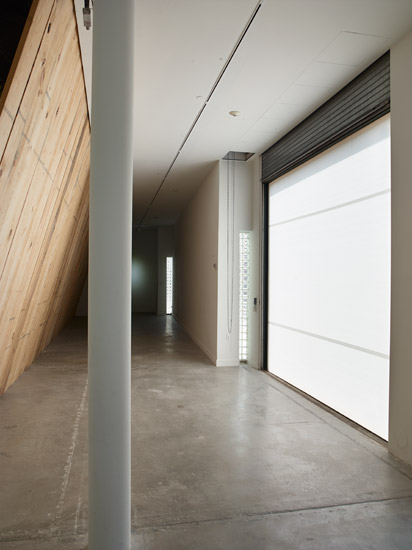Call it Southern vernacular expression meets Minimalist DIY aesthetics.
Virginia Overton forges a distinctive hybrid in contemporary art: Her work suggests oblique ties to an iconic Folk Art landmark in Georgia, Howard Finster’s Paradise Garden. As an untrained artist working with found objects, Finster sometimes favored hubcaps and bicycle parts; Overton has built sculptures from a tractor tire and tow rope.
Nevertheless, her formal links to artists like Richard Serra and Eva Hesse are more apparent. In “Virginia Overton: Flat Rock” at North Miami’s Museum of Contemporary Art, she bridges the massive, macho sensibility of Richard Serra with down-to-earth and DIY modes of expression she learned growing up in rural Tennessee.
.

"Untitled" by Virginia Overton, 2014. Steel, aluminum, sandbags, and wood.
.
“I think the roughness of my work comes from the fact that I grew up on a farm,” the artist told Interview magazine. “You learn to use and reuse the materials in a pretty thrifty way.” With a sculptor’s talent for assembling balanced and joined objects, her take on what’s rough and recycled reinvents Serra’s industrial-strength sculpture, such as his Corner Prop (1969) and infamous Tilted Arc (1981). To this visual mash-up she adds sensuous elements of sound, movement, and scents, especially that of raw lumber.
Curated by the museum’s Interim Director and Chief Curator Alex Gartenfeld, "Flat Rock" is Overton's first solo exhibition at an American museum. Overton has exhibited internationally and nationally in museums and galleries, including New York City. She is based in Brooklyn, NY.
Art Made For Its Environment
Southern-style qualities in Overton’s art prevail in subtle, rarely discussed ways. Finster’s interest in creating an environmental artwork such as Paradise Garden, spanning several acres, hardly makes him unique among artists in the American South. Moreover, his creative talents embraced poetry and music, drawing on the region’s rich musical tradition.
Of course, gentle whirring sounds from an electric fan or “white noise” machine for lulling restless people to sleep, the aural elements in art in “Flat Rock,” are a long way from Finster’s banjo performances. Consider a new installation, Outlooks, at Storm King Art Center in New York's Hudson Valley. Working with four-inch-diameter brass tubing, she’s created a sculptural drawing in space. It floats and slopes four feet above a large field at the Storm King Art Center, echoing the field’s topography. Since musical instruments are often made of brass, her sculpture carries sounds readily, engaging visitors with both sound and sight.
Minimalist DIY Aesthetics Made for Miami
For “Flat Rock,” Overton’s first solo show in an American museum, she characteristically spent several months researching the area where her art would be exhibited. In Miami, that meant visiting thrift shops and flea markets. Overton was also fascinated by recycling businesses along the Miami River, where she discovered an aging, industrial hunk of steel for a fountain at MOCA. It fits with the recycled, found objects she prefers, as her art evocatively capitalizes on such objects’ aura of blue-collar sensibility.
In front of the museum is Overton’s jerry-rigged fountain, Untitled (2014), in which water travels down angled aluminum troughs to land on a rusty, 501-lb. steel cylinder before spilling into the circular pool that graces the museum plaza. Slicing across an elegant vista of palms planted along the plaza, the aluminum troughs create an awkward, rough-hewn presence in stark contrast to their tropical urban surroundings.
Another Untitled (2014), this one of wood and tarp, is Overton’s site-specific lightbox. Greeting visitors to the exhibit, it brilliantly fuses her DIY practicality with a Minimalist aesthetic. She discovered a doorway for a loading dock not currently in use at MOCA that had been sealed behind a wall for displaying artwork.
.

"Untitled" by Virginia Overton, 2014. Poly tarp, wood.
.
The artist first had the wall torn down to expose the doorway. Then she covered this existing opening with white tarp, allowing Miami’s intense natural light to shine through, illuminating the space via a truly “green” light box.
Close inspection reveals a miniscule grid formed by the weave of this tarp. Tiny vertical and horizontal lines intersect in faintest shades of gray, ingeniously resulting in a white rectangular form resembling a geometric painting by Agnes Martin.
Untitled (Goodyear) (2014) speaks directly to Overton’s rural upbringing as well as her precise attention to the sculptor’s craft of engineering balance and stability among objects. A black tractor tire rests upright on the floor at a slight tilt, precisely if precariously supported by a single, tilted wooden plank. The tilted angles here echo tilted wooden planks forming two adjacent partitions in the gallery space, which are also untitled works in the exhibit. Tucked inside the tire are gadgets contrasting with the tire’s lo-tech past: a car battery, inverter, and softly whirring white-noise machine.
.

"Untitled (Goodyear)" by Virginia Overton, 2014. Tractor tire, wood, car battery, inverter, white noise machine.
.
Time and again, Overton engineers unlikely juxtapositions of meaning and materials, bringing provocative new twists to emblems appropriated from the making of objects for art and industry.
BASIC INFO: “Virginia Overton: Flat Rock” continues through July 6, 2014. The exhibition is located at the Joan Lehman Building, Museum of Contemporary Art, 770 NE 125th Street, North Miami, Florida 33161. www.MOCAnomi.org.
__________________________
Copyright 2015 Hamptons Art Hub LLC. All rights reserved.

Thank you Hampton Art Hub for the voice of Elisa Turner. In Miami we have read Elisa’s reviews in The Miami Herald, Art Circuits and Art News. It is wonderful to see her at The Hampton Art Hub.
Diaspora Vibe mounted an exhibition in 2012 in South Hampton.
Readers will be delight to absorb this new voice to The Hamptons.
Congratulations.
Rosie
Great slowly pealing away and revealing the essence and influences that contemporary academic artists draw from non-academic visual practitioners. Geography illuminates accountability in the case of Virginia Overton’s work as Elisa Turner articulates. Indeed, self-taught non-academic artists like Antoni Tapies and Frances Bacon can attest to the many institutionally trained artists out there today. Great insight Ms. Turner!